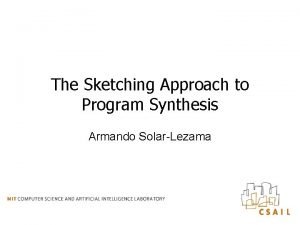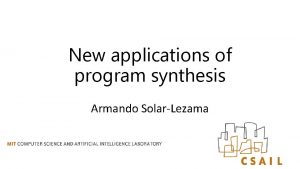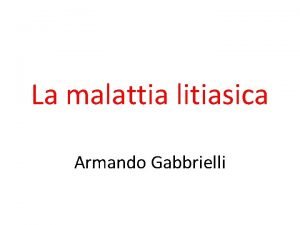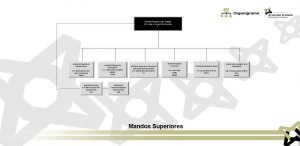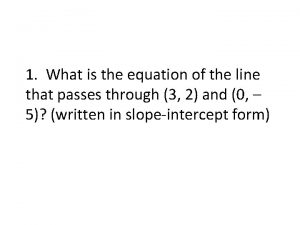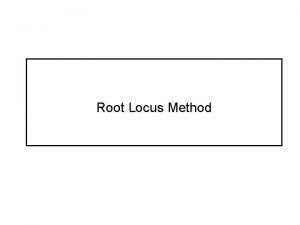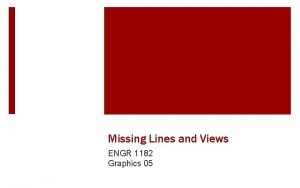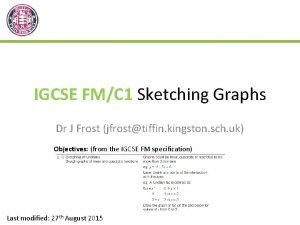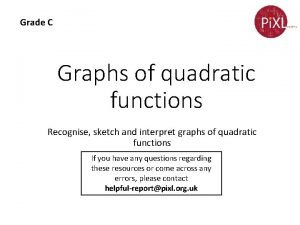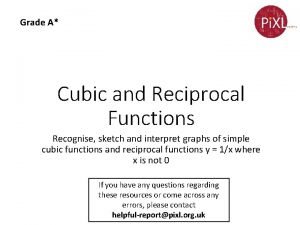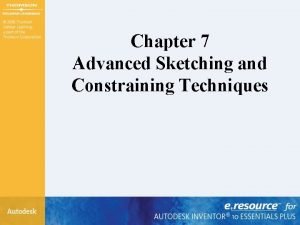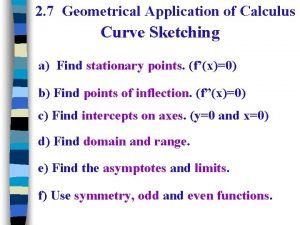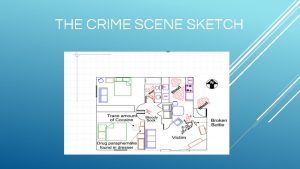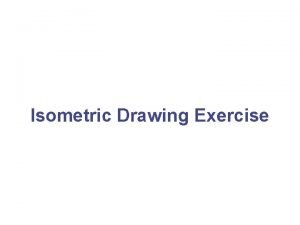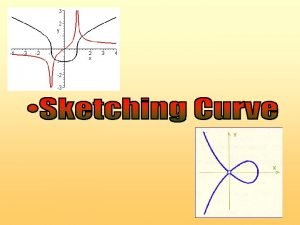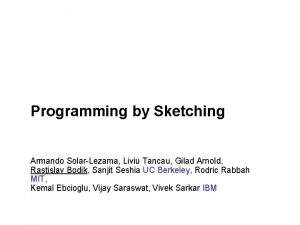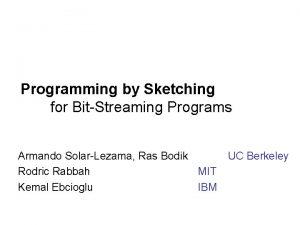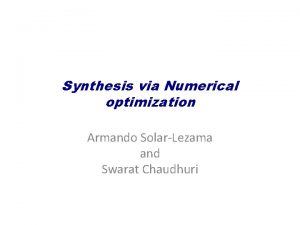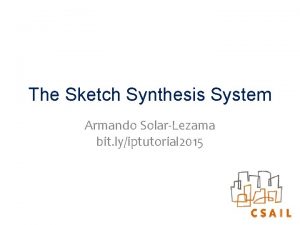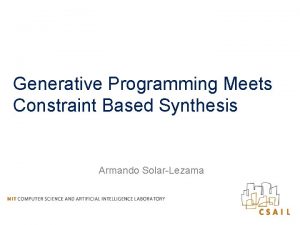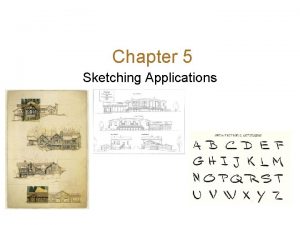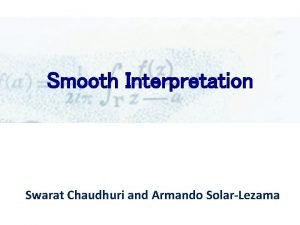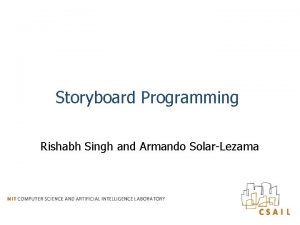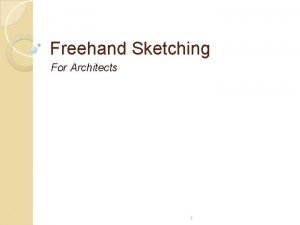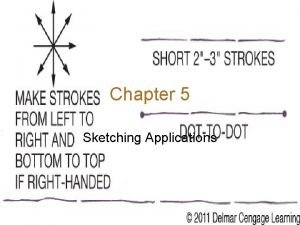The Sketching Approach to Program Synthesis Armando SolarLezama





![Example Test harness for a linked list based Queue: Bound void test(int[N] in){ Array. Example Test harness for a linked list based Queue: Bound void test(int[N] in){ Array.](https://slidetodoc.com/presentation_image_h/0f4f8507ca9d154a39e3a735d5fc4664/image-6.jpg)

![Example Test harness for a Linked List Reversal: void check(int n, list l, node[N] Example Test harness for a Linked List Reversal: void check(int n, list l, node[N]](https://slidetodoc.com/presentation_image_h/0f4f8507ca9d154a39e3a735d5fc4664/image-8.jpg)



























![Projection Algorithm: Key Ideas Sk[c] if(c){ S 1; }else { S 2; S 3; Projection Algorithm: Key Ideas Sk[c] if(c){ S 1; }else { S 2; S 3;](https://slidetodoc.com/presentation_image_h/0f4f8507ca9d154a39e3a735d5fc4664/image-36.jpg)






- Slides: 42

The Sketching Approach to Program Synthesis Armando Solar-Lezama

The Challenge Computer should help make programming easier Problem - Programming requires insight and experience - Computers are not that smart Interaction between programmers and tools is key

The sketching approach New programming model based on localized synthesis Let the programmer control the implementation strategy Focus the synthesizer on the low-level details Key design principle: - Exploit familiar programming concepts

Sketch language basics Sketches are programs with holes - write what you know - use holes for the rest 2 semantic issues - specifications • How does SKETCH know what program you actually want? - holes • Constrain the set of solutions the synthesizer may consider

Specifications Idea: Use tests as specification - Programmers know how to write those Non-determinism in the test improves coverage - System ensures test will pass for all inputs/choices
![Example Test harness for a linked list based Queue Bound void testintN in Array Example Test harness for a linked list based Queue: Bound void test(int[N] in){ Array.](https://slidetodoc.com/presentation_image_h/0f4f8507ca9d154a39e3a735d5fc4664/image-6.jpg)
Example Test harness for a linked list based Queue: Bound void test(int[N] in){ Array. Queue arr. Queue = new Array. Queue(); ll. Queue arr. Queue = new ll. Queue(); for(int i=0; i<N; ++i){ Known implementa Sketched implementation if(*){ arr. Queue. enqueue(in[i]); ll. Queue. enqueue(in[i]); }else{ assert arr. Queue. empty() == ll. Queue. empty(); non-determinism if(!arr. Queue. empty()) assert arr. Queue. dequeue() == ll. Queue. dequeue(); } } } Assertions

Example Test harness for a Linked List Reversal: Bound void main(int n){ assume n < N; node[N] nodes = null; list l = new. List(); populate. List(n, l, nodes); // write list to nodes array l = reverse. SK(l); check(n, l, nodes); } Sketched implementation Assertions
![Example Test harness for a Linked List Reversal void checkint n list l nodeN Example Test harness for a Linked List Reversal: void check(int n, list l, node[N]](https://slidetodoc.com/presentation_image_h/0f4f8507ca9d154a39e3a735d5fc4664/image-8.jpg)
Example Test harness for a Linked List Reversal: void check(int n, list l, node[N] nodes){ node cur = l. head; int i=0; while(cur != null){ assert cur == nodes[n-1 -i]; cur = cur. next; i = i+1; } assert i == n; if(n > 0){ assert l. head == nodes[n-1]; assert l. tail == nodes[0]; assert l. tail. next == null; }else{ assert l. head == null; assert l. tail == null; } } Assertions

Holes are placeholders for the synthesizer - synthesizer replaces hole with concrete code fragment - fragment must come from a set defined by the user Defining sets of code fragments is the key to Sketching effectively

Integer hole Define sets of integer constants Example: Hello World of Sketching spec: int foo (int x) { return x + x; } sketch: int bar (int x) implements foo { return x * ? ? ; } Integer Hole

Integer Holes Sets of Expressions with ? ? == sets of expressions - linear expressions - polynomials - sets of variables x*? ? + y*? ? x*x*? ? + ? ? ? x : y

Integer Holes Sets of Expressions with ? ? == sets of expressions - linear expressions - polynomials - sets of variables x*? ? + y*? ? x*x*? ? + ? ? ? x : y Semantically powerful but syntactically awkward - Regular Expressions are a more convenient way of defining sets

Regular Expression Generators {| Reg. Exp |} Reg. Exp supports choice ‘|’ and optional ‘? ’ - can be used arbitrarily within an expression • • to select operands to select operators to select fields to select arguments {| (x | y | z) + 1 |} {| x (+ | -) y |} {| n(. prev |. next)? |} {| foo( x | y, z) |} Set must respect the type system - all expressions in the set must type-check - all must be of the same type

Least Significant Zero Bit Example: Least Significant Zero Bit - 0010 0101 0000 0010 int W = 32; bit[W] isolate 0 (bit[W] x) { // W: word size bit[W] ret = 0; for (int i = 0; i < W; i++) if (!x[i]) { ret[i] = 1; return ret; } } Trick: - Adding 1 to a string of ones turns the next zero to a 1 - i. e. 000111 + 1 = 001000 !(x + ? ? ) & (x + ? ? ) !(x + 1) & (x + 0 x. FFFF) !(x + 0) & (x + 1) !(x + 0 x. FFFF) & (x + 1)

Integer Holes Sets of Expressions ◦ Example: Least Significant Zero Bit - 0010 0101 0000 0010 int W = 32; bit[W] isolate 0 (bit[W] x) { // W: word size bit[W] ret = 0; for (int i = 0; i < W; i++) if (!x[i]) { ret[i] = 1; return ret; } bit[W] isolate. Sk (bit[W] x) implements isolate 0 { return !(x + ? ? ) & (x + ? ? ) ; } }

Least Significant Zero bit ◦ How did I know the solution would take the form !(x + ? ? ) & (x + ? ? ). ◦ What if all you know is that the solution involves x, +, & and !. bit[W] {| x | return tmp=0; tmp |} = {| (!)? ((x | tmp) (& | +) (x | tmp | ? ? )) |}; tmp; This is now a set of statements (and a really big one too)

More Constructs: repeat Avoid copying and pasting - repeat(n){ s} s; s; …s; n - each of the n copies may resolve to a distinct stmt - n can be a hole too. bit[W] tmp=0; repeat(? ? ){ {| x | tmp |} = {| (!)? ((x | tmp) (& | +) (x | tmp | ? ? )) |}; } return tmp; Keep in mind: - the synthesizer won’t try to minimize n

Putting it together: Linked List Reverse Efficient implementation uses imperative updates and a while loop list reverse(list l){ list nl = new list(); node tmp = null; while( l ){ l } return nl; } This should be a pointer comparison (nl | l) (. head |. tail)(. next)? | null 18

Putting it together: Linked List Reverse Efficient implementation uses imperative updates and a while loop #define LOC {| (nl | l) (. head |. tail)(. next)? | null |} #define CMP {| LOC ( == | != ) LOC |} list reverse(list l){ list nl = new list(); node tmp = null; while( CMP ){ l } return nl; } This should be a series of pointer assignments possibly guarded by conditions 19

Putting it together: Linked List Reverse #define LOC {| (nl | l) (. head |. tail)(. next)? | null |} #define CMP {| LOC ( == | != ) LOC |} #define LHS {| (tmp | (l | nl)(. head |. tail))(. next)? |} list reverse(list l){ list nl = new list(); node tmp = null; while( CMP ){ repeat(? ? ) if(CMP){ LHS = {| LOC | tmp |}; } } return nl; } 20 This resolves in less than 1 min

Example: remove() for a sorted, linked list The data structure: - linked list of Nodes - sorted by Node. key - with sentries at head and tail -∞ a b c +∞ The problem: implement a concurrent remove() method 21

Thinking about the problem Sequential remove (): -∞ a b c +∞ Insight 1: for efficiency, use fine-grain locking - of individual Nodes, rather than the whole list Insight 2: Keep a sliding window with two locks 22

Hand Over Hand Locking bit add(Set S, int key) { bit ret = 0; Node prev = null; Node cur = S. head; void find (Set S, int key, ref Node prev, ref Node cur) { while (cur. key < key) { aas if(? ? ) lock(LOC); reorder{ if(COMP) lock(LOC); if(COMP) unlock(LOC); aas find (S, key, prev, cur); if (key < cur. key) { prev. next = new. Node (key, cur); ret = 1; } else { ret = 0; } { prev = cur; cur = cur. next; } } aas if(? ? ) unlock(LOC); return ret; } #define COMP {| ((cur|prev)(. next)? | null) (== | !=) (cur|prev)(. next)? #define LOC {| (cur | prev )(. next)? |} |}

Defining the synthesis problem

Defining a solution to a sketch Defined in terms of a control function - Control defines an integer value for each hole Values in the sketch are parameterized by - i. e. program values depend on the values of holes Goal: - Find a control such that all assertions succeed for all inputs

Solving sketches sequentially Syntax directed translation finds constraints int lin(int x){ return ? ? *x + ? ? ; } void main(int x){ int t 1 = lin(x); int t 2 = lin(x+1); assert lin(0) == 1; if(x<4) assert t 1 >= x*x; if(x>=3) assert t 2 -t 1 == 3; }

Solving sketches sequentially Syntax directed translation finds constraints int lin(int x){ return φ(? ? 1)*x + φ(? ? 2); } φ(? ? 1) = 3 φ(? ? 2) = 1 is a valid solution. void main(int x){ int t 1 = lin(x); int t 2 = lin(x+1); φ(? ? 1)*0 + φ(? ? 2) == 1 assert lin(0) == 1; if(x<4) assert t 1 >= x*x; if(x>=3) assert t 2 -t 1 == 3; } x < 4 φ(? ? 1)*x + φ(? ? 2) >= x*x x >=3 φ(? ? 1)*(x+1) - φ(? ? 1)*x == 3

A Sketch as a constraint system Synthesis reduces to constraint satisfaction A φ. x. Q(x, φ) E Constraints are too hard for standard techniques - 28 Universal quantification over inputs Too many constraints Too many holes

Insight Sketches are not arbitrary constraint systems - They express the high level structure of a program A small number of inputs can be enough - focus on corner cases A φ. Q(x, x in E. φ) where E = {x 1, x 2, …, xk} E This is an inductive synthesis problem ! 29

Counterexample –Guided Inductive Synthesis (CEGIS) Sequential candidate implementation succeed Inductive Synthesizer • Derive candidate implementation from concrete inputs. A φ. buggy Q(x, x in E. φ) E observation set E 30 fail counterexample input Automated Validation Your verifier/checker fail goes here ok

What about concurrency?

Reframing the problem Sequential constraints are in terms of inputs - derived from the sequential semantics of the program A φ. x. Q(x, φ) E Concurrent constraints defined in terms of traces - traces have sequential semantics set of traces of the sketch A φ. t in tr(P). Q(t, φ) E We can do inductive synthesis on traces as well!

Counterexample –Guided Inductive Synthesis (CEGIS) Sequential Concurrent succeed candidate implementation Inductive Synthesizer Derive candidate implementation from concrete inputs. counterexample traces φ. A • fail buggy Automated Validation SPIN Your verifier/checker t in Q(t, E. φ) goes here fail E counterexample trace input observation set E traces of the sketch != trace of a candidate ok

Learning from traces Problem: Traces are only relevant to the program they came from Trace on sketch S Solution: Trace Projection tp ► S Trace on program P Desired property - if P’ shares the bug exposed by tp … … tp ► S should expose the bug too - allows inductive synthesis through constraint solving 34

How to do projection The key is to preserve statement ordering - statements in the trace ⊆ statements in the Control flow may be an obstacle - but we can get rid of it
![Projection Algorithm Key Ideas Skc ifc S 1 else S 2 S 3 Projection Algorithm: Key Ideas Sk[c] if(c){ S 1; }else { S 2; S 3;](https://slidetodoc.com/presentation_image_h/0f4f8507ca9d154a39e3a735d5fc4664/image-36.jpg)
Projection Algorithm: Key Ideas Sk[c] if(c){ S 1; }else { S 2; S 3; } S 4; c=1 c=0 P = Sk[0] Sk tp ► Sk S 2; S 3; S 4; if(c) S 1; if(!c) S 2; if(!c) S 3; S 4; 36 S 4; Want a parameterized set of traces preserve order of common statements Algorithm 1. If-Conversion of the Sketch t. P S 2; S 3; S 4; Easier to build a trace 2. Schedule the statements preserve order from original trace

Sample of what sketch can do Bit-level manipulations - If you want to do low-level bit-vector manipulations use sketch - don’t waste time doing it by hand… - …but don’t expect the SAT solver to break crypto functions Integer problems - very good at coming up with tricky arithmetic expressions - … but only when used with an SMT solver backend Data-structures - Very good at local manipulations of lists and trees - We have sketched some interesting graph algorithms Concurrent objects - Various implementations of locked and lock-free manipulations of lists/queues - Synchronization objects such as 2 -phase barrier

So are all the problems now solved? NO! ◦ Synthesis is in its infancy ◦ Big opportunities for improvement

The big problems Scalability - how do we scale to bigger programs? Scalability - how do we scale to bigger holes? Scalability - how do you scale to programs that require complex high-level reasoning?

The really big problems How do we scale to bigger programs? - it’s not about making the solver faster • although that helps - it’s about achieving modularity How do we scale to bigger holes? - it’s not about making the solver faster • although that helps - it’s about capturing insight at the right level of abstraction What about complex reasoning? - it’s not about making the solver faster • although that helps - it’s about capturing domain knowledge

Some directions of new research Abstraction enhanced sketching - discover facts about the solution by analyzing abstract sketch - use these facts to boost scalability of CEGIS Sketching for very large programs - use data-driven abstractions to model the program behavior - synthesizer learns by observation Sketching for numerical control software - very important domain - reasoning about discrete and numerical computation in tandem

Points to take home It’s time for a revolution in programming tools - Unprecedented ability to reason about programs - Unprecedented access to large-scale computing resources - Unprecedented challenges faced by programmers Successful tools can’t ignore the programmer - programmers know too much to be replaced by machines - but they sure need our help!
 Venerated quarrel
Venerated quarrel Sergio mansilha
Sergio mansilha Armando solar-lezama
Armando solar-lezama Armando maglio
Armando maglio Armando solar-lezama sketch c like language with holes
Armando solar-lezama sketch c like language with holes Bernd jürgen armando brandes
Bernd jürgen armando brandes Dr rivero armando
Dr rivero armando Armando cosentino
Armando cosentino Foda historia
Foda historia Armando jorge carneiro
Armando jorge carneiro Armando iturralde
Armando iturralde Armando iacovantuono
Armando iacovantuono Armando romanelli
Armando romanelli Armando catania
Armando catania Diverticolo paravateriano
Diverticolo paravateriano Armando sierralta
Armando sierralta Armando cordova cortazar
Armando cordova cortazar Define armando
Define armando José armando lópez falcón
José armando lópez falcón Armando sierralta
Armando sierralta Dr armando rivero
Dr armando rivero Joropo dress
Joropo dress Pass
Pass Colegio ing armando i santacruz
Colegio ing armando i santacruz Ing. ernesto cepeda aldape
Ing. ernesto cepeda aldape Armando bought 45 baseball cards
Armando bought 45 baseball cards Crime scene rough sketch
Crime scene rough sketch Sketching vocabulary
Sketching vocabulary Sketching crime scene
Sketching crime scene Root locus sketching
Root locus sketching Learning objectives for drawing
Learning objectives for drawing Missing view problems engineering drawing
Missing view problems engineering drawing Isometric sketching
Isometric sketching Dr j frost
Dr j frost Sketch graph of quadratic function
Sketch graph of quadratic function How to draw reciprocal graphs
How to draw reciprocal graphs Crime scene sketches examples
Crime scene sketches examples Sketch chapter 7
Sketch chapter 7 Sketching graphs calculus
Sketching graphs calculus Crime
Crime Sketching as a tool for numerical linear algebra
Sketching as a tool for numerical linear algebra Isometric drawing examples
Isometric drawing examples Curve sketching examples with solutions doc
Curve sketching examples with solutions doc


